What is satin? Satin isn't actually a specific fabric. It's a sophisticated weaving technique that creates that iconic smooth, glossy surface you'll recognize from luxury fashion.
Originally developed in China over 2,000 years ago using silk, today's satin can be crafted from various fibers, including polyester, rayon, and nylon.
Fashion designers love satin for its versatile properties. The distinctive sheen, elegant drape, and luxurious feel make it perfect for everything from wedding gowns to evening wear. Understanding satin's unique characteristics will reveal why it remains a timeless favorite in fashion.
Key Takeaways
- Satin is a luxurious weaving method that creates smooth, glossy fabric from various fibers like silk, polyester, or rayon.
- The unique structure produces a lustrous surface that reflects light. This makes garments appear elegant and high-end.
- Fashion designers value satin's exceptional draping qualities. This allows the fabric to flow gracefully around the body.
- Satin's versatility allows designers to create everything from formal evening wear to casual pieces with sophistication.
What Is Satin? The History and Origins
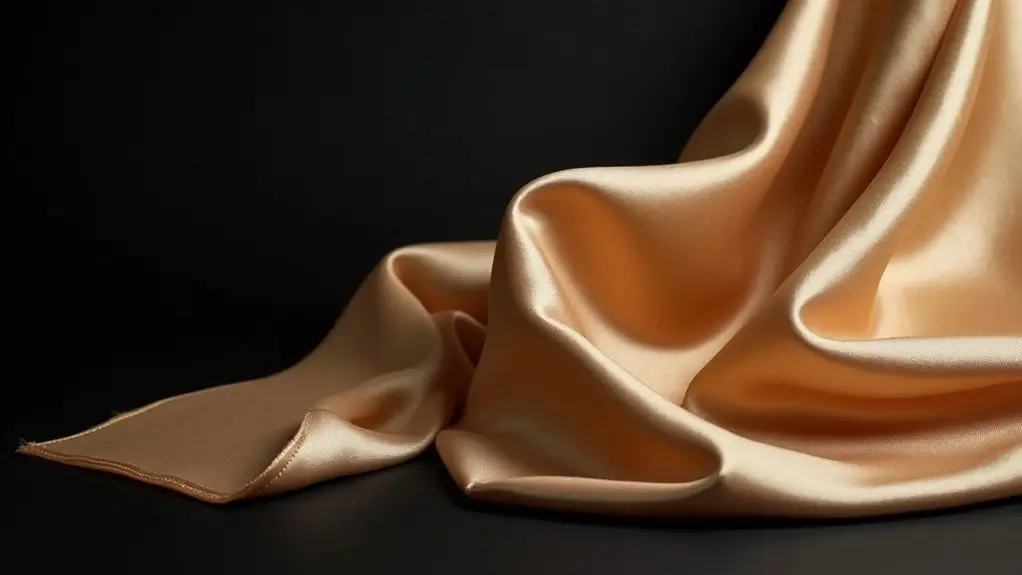
Many luxurious fabrics have graced the fashion world. Satin's remarkable journey began over 2,000 years ago in the bustling port city of Quanzhou, China.
Its name comes from "Zaitun," the Arabic word for this historic port where the unique weave was first developed.
What started as an exclusively silk-based fabric in China soon caught Europe's attention.
By the 12th century, Italian textile makers were crafting their own satin weaves. By the 14th century, you'd find this lustrous fabric adorning the wardrobes of nobility and church officials.
The fabric's complex weaving method created a smooth, reflective surface that became synonymous with luxury.
Understanding Satin Weave Construction
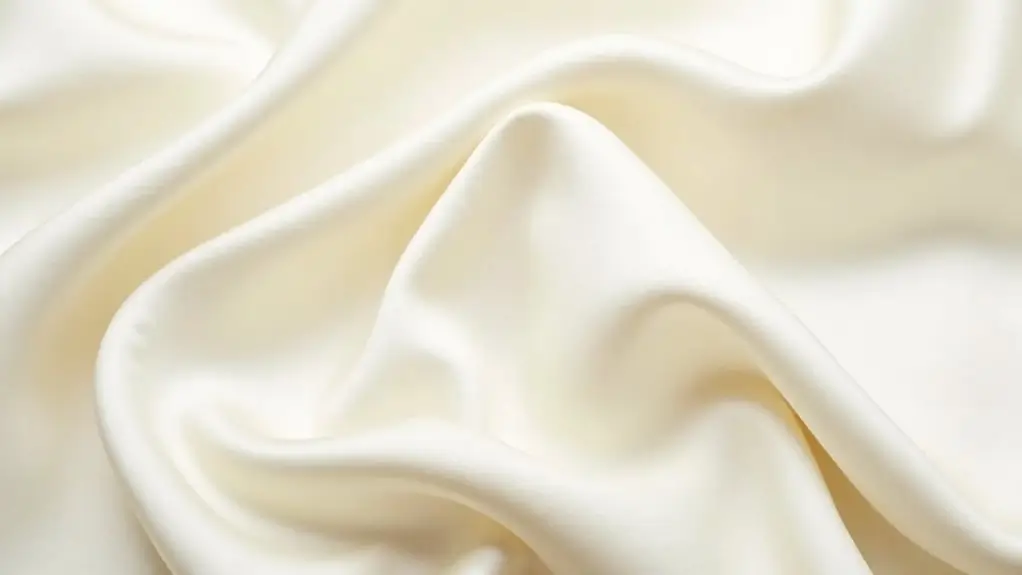
The intricate construction of satin weave sets it apart from other fabric patterns in the textile world.
Satin isn't just one specific type of fabric. It's actually a unique weaving method that can be used with silk, polyester, or other filament fibers.
When you look closely at satin's construction, you'll notice how the threads are arranged to create a smooth, glossy surface.
The weave's design allows long floating yarns to skip over several cross-threads before interlacing. This creates the characteristic shine you’re familiar with.
Different types of satin fabric vary based on the number of threads that "float" across the surface. This affects both their appearance and durability.
Types of Fibers Used in Satin Production
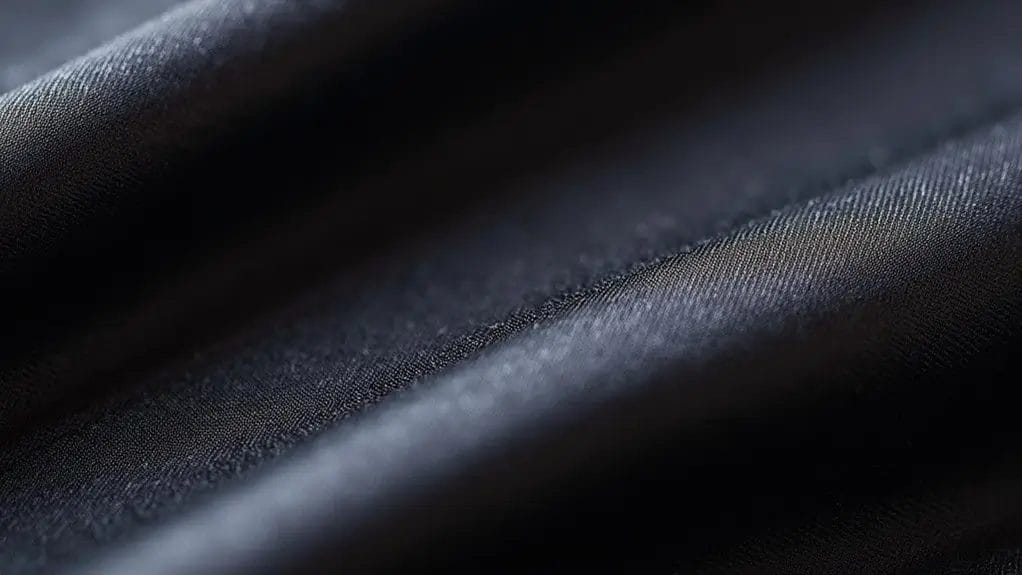
Modern manufacturing offers diverse options. So you'll find satin made from both natural and synthetic fibers in today's market. The type of fiber used greatly impacts the fabric's characteristics, durability, and care requirements.
- Silk creates exquisite, high-end satin fabric with exceptional drape and sheen.
- Polyester satin is affordable, durable, and resistant to wrinkles.
- Rayon offers a silk-like feel with better breathability than synthetic options.
- Nylon creates a strong, lightweight satin perfect for activewear.
- Acetate delivers a crisp texture ideal for formal garments.
Each fiber choice affects how the satin weave performs. Charmeuse satin has fluid movement, while duchess satin offers structured elegance.
Properties and Characteristics of Satin
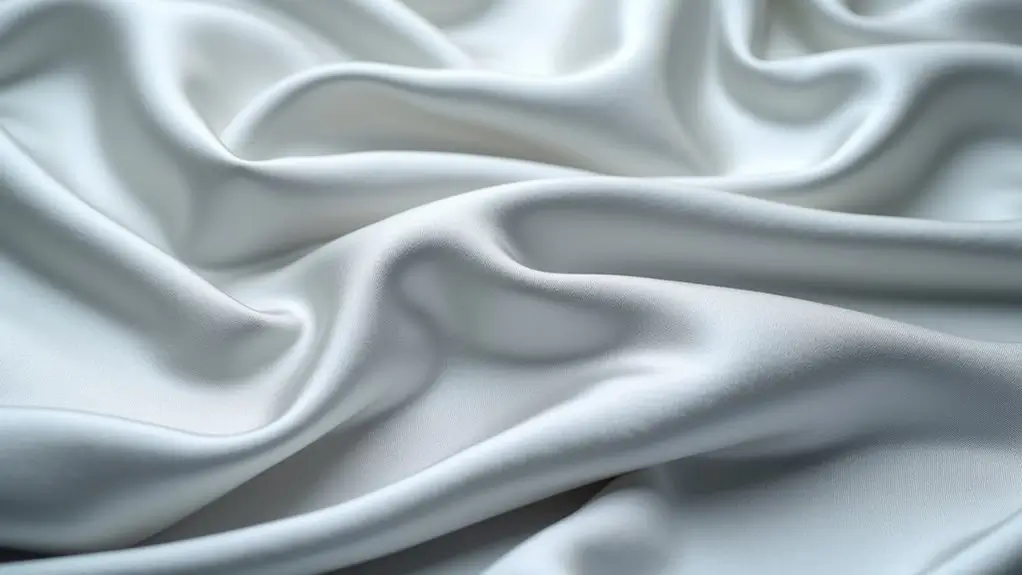
The satin weave creates a smooth fabric that is incredibly soft. It has a characteristic shine on one side and a matte finish on the other.
| Property | Characteristic | Impact |
|---|---|---|
| Surface | Lustrous | Reflects light beautifully |
| Texture | Smooth | Feels luxurious on skin |
| Structure | Complex weave | Provides durability |
Satin made from silk offers the most luxurious feel. Synthetic versions also maintain similar characteristics. When working with satin, remember that its unique structure requires special care to retain its distinctive sheen.
Common Uses and Applications of Satin

When exploring satin's versatility, you'll find it's a powerhouse material in multiple design applications.
Home Decor and Furnishings
Many interior designers rely on satin fabrics to add luxury and elegance to home furnishings.
You’ll find various types of satin used throughout the home. Decorative satin pillows add style to living spaces. Lustrous window treatments made of satin create a sophisticated ambiance.
When it comes to bedding, satin sheets and duvet covers are particularly popular. They're smooth against your skin and add a hotel-like quality to your bedroom.
With its soft sheen and distinctive weave, satin is perfect for upholstery, too.
You'll often see antique satin fabric used for dining room chairs, throw pillows, and formal draperies that catch and reflect light beautifully.
Clothing and Fashion
Beyond its role in home decor, satin fabric takes center stage in the fashion world. You'll find this material in everything from elegant evening gowns to chic accessories.
| Garment Type | Popular Satin Choice | Best Features |
|---|---|---|
| Evening Wear | Charmeuse Satin | Fluid drape, subtle sheen |
| Bridal Gowns | Duchess Satin | Structure, rich luster |
| Accessories | Lucent Satin | Double-sided shine |
When shopping for satin garments, remember that satin is a type of weave, not a specific fiber. Silk satin offers premium luxury. But you can also find beautiful options made from polyester or rayon at a lower cost.
Accessories and Formal Wear
Satin's versatility shines brightest in formal wear and accessories. You'll find this fabric draped across wedding gowns, wrapped around evening shoes, and crafted into elegant bow ties.
The satin weave technique creates that unmistakable shimmer in formal handbags. Duchess satin holds its shape perfectly in structured headpieces and waist sashes.
Watch for charmeuse satin in scarves and wraps. Its fluid drape adds sophistication to any evening ensemble.
Care and Maintenance Guide for Satin
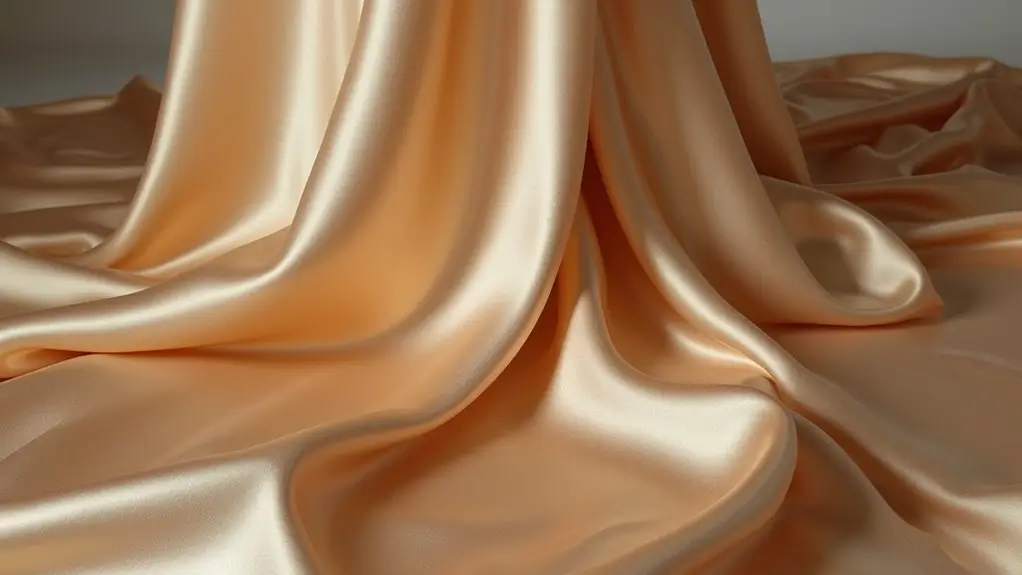
Proper care greatly extends the lifespan of satin garments. Understanding maintenance techniques is essential for preserving their sheen and texture.
When caring for satin items, you'll need different approaches based on the fiber type. Silk requires dry cleaning, while synthetic fibers can handle machine washing.
For washable satin, use cold water and gentle detergent on a delicate cycle.
Turn garments inside out and place them in a mesh bag to prevent snags.
After washing, don't wring or twist the fabric. Instead, lay it flat to dry away from direct sunlight.
How to Choose Quality Satin Products
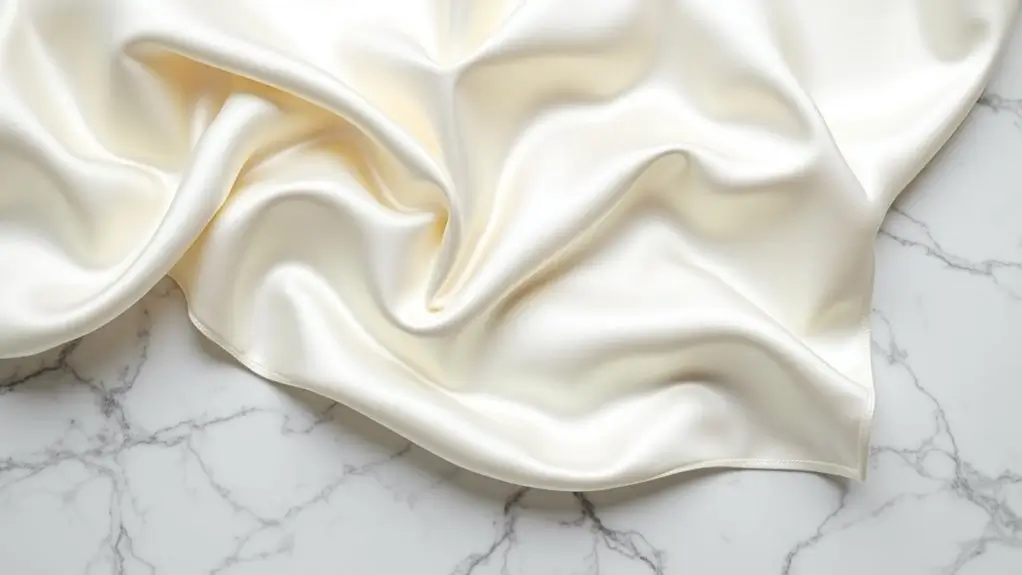
When shopping for satin products, you'll need to know how to identify genuine quality. Satin is a popular type of weave rather than a specific material. So, understanding what it's made from is essential.
| Quality Check | What to Look For | Why It Matters |
|---|---|---|
| Fiber Content | Silk vs synthetic fibers | Affects durability |
| Surface Shine | Even sheen distribution | Shows craftsmanship |
| Weight/Drape | Proper thickness | Indicates use case |
You'll want to examine the surface of satin for any irregularities. The unique shimmering effect should be consistent, whether it's made from polyester or silk. Remember that care and considerations vary greatly between natural and synthetic satin fabrics.
Silk Vs Satin: Difference Between Silk and Satin
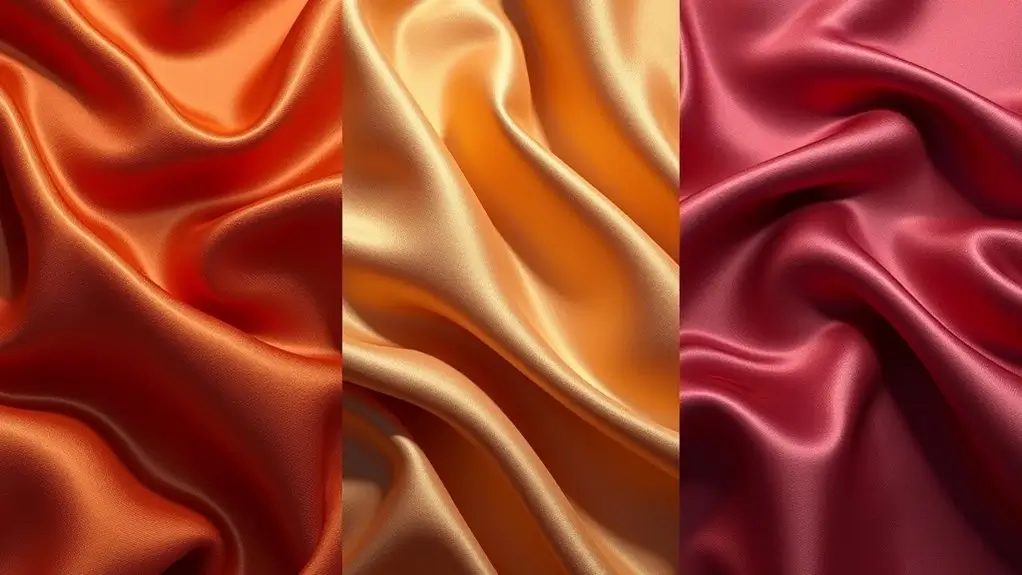
While satin is a weaving technique, silk is a natural fiber. When comparing satin vs silk, the differences between satin and silk are important. Silk satin combines the elegant silk fiber with the glossy satin weave. But satin can also be made from synthetic fibers, which affects feel, durability, and care.
| Feature | Silk Fabric | Satin Fabric |
|---|---|---|
| Definition | Natural protein fiber from silkworms | Weaving technique producing smooth, glossy surface |
| Material | Pure silk fibers | Can be silk, polyester, rayon, nylon, etc. |
| Texture | Soft, smooth, and natural shine | Glossy on one side, matte on the other |
| Durability | Delicate, requires careful handling | Varies: silk satin delicate; polyester satin more durable |
| Price | Expensive due to natural origin | More affordable options available with synthetic fibers |
| Care | Usually dry clean only | Synthetic satin can often be machine washed; silk satin needs gentle care |
| Appearance | Natural, subtle sheen | Bright, reflective shine due to weave |
| Use Cases | High-end fashion, luxury bedding | Evening wear, bridal gowns, accessories, upholstery |
In summary, silk refers to the fiber, while satin refers to the weave. Silk satin provides an unmatched combination of softness and sheen. But it comes with a higher cost and delicate care requirements.
Synthetic satin offers affordability and durability. It has similar glossy aesthetics but a less natural feel. Understanding these differences helps you choose the right fabric for your needs.
Conclusion
Satin's enduring appeal lies in its remarkable versatility and timeless elegance. Whether you choose a wedding gown, formal wear, or luxurious bedding, those distinctive features make satin a standout choice.
Understanding its proper care and construction will help you select quality satin pieces. It's no wonder this ancient weaving technique continues to captivate designers and consumers alike.
Learn more fabric knowledge on the Longan Craft Blog, and dive into the fabric world with Longan Craft!
FAQs
Can Satin Fabric Be Sustainably Produced and Recycled?
Satin's sustainability depends on its materials. While synthetic satins aren't eco-friendly, those made from natural fibers are recyclable. Look for sustainable options like recycled polyester or biodegradable silk satin.
Does Satin Fabric Cause Allergic Reactions or Skin Irritations?
Your skin's reaction to satin depends on the fiber it's made from, not the weave itself. If you're sensitive to synthetic materials, you'll want to choose natural silk.
How Does Satin Compare to Velvet in Terms of Durability?
Satin and velvet have different durability levels. Satin's delicate weave makes it more prone to snags and pulls compared to velvet's sturdier pile construction.
Can Satin Fabric Be Effectively Used for Outdoor Furniture?
You shouldn't use regular satin for outdoor furniture as it's prone to weather damage. If you want the look, pick antique satin made for upholstery with weather-resistant synthetic fibers.


0 comments